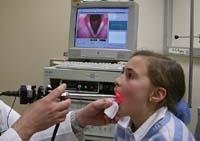Attention to the voice

According to some studies, 62% of teaching people have voice problems and most, 42%, have functional dysphonia, that is, they do not use the voice properly. The teaching team is the lowest received by voice problems.
In general, approximately 5% of the Spanish population has voice problems. Most voice problems occur between the ages of 25 and 45 and are more common among women than among men. The size and location of the larynx varies by sex. The female larynx is smaller than the male one, so its vocal cords are also smaller. Therefore, in general, more vocal cord injuries occur due to misuse of voice or excessive voice violation. Moreover, when these inappropriate uses become customs.
Despite being a problem that mainly affects adults, children have also shown the damage caused by improper use of the voice in recent years. Statistics show that between 40% and 60% of children have voice problems. At 6-8 years of age and at puberty they are the ones that are most given, and boys have more than girls. Before puberty, the dimensions and location of the larynx are equal in both sexes. However, in general, the expert of the University Clinic of Navarra Secundino Fernández explains that the phonatory apparatus of the boys is more hyperfunctional than that of the girls. And is that in relationships between friends, in games, etc. boys force more to fonation organs. In both children and adults, dysphonia may be due to an anatomical problem of the larynx or a dysfunction of a phonatory organ. The most common pathologies are nodules.
Dysphonia
In most cases, dysphonia is due to misuse of the voice, that is, misuse or forcing of the voice. Talk too much or with inadequate strength and tone, shout, cough, sing with inadequate technique, breathe dust or tobacco smoke... In these cases there is no anatomical injury to the fonation organs.

However, organic dysphonia is based on lesions of phonatory organs, usually nodules and polyps. However, dysphonia may also occur due to traumatic causes, both for audiogenic reasons (due to poor listening) and for psychogenic reasons.
There are three main ways of treating dysphonia: medicines, rehabilitation, and surgery. Many times it is enough with rehabilitation to cure a dysphonia, correcting our bad habits of voice use: use techniques of relaxation of the larynx, work respiratory coordination, sound and vocal, use all the phonatory means of the patient --especially the air of the lungs, which is the one that provides the basic energy for the creation of the voice. These techniques are applied in the case of newly created nodules, but not in the old ones. In them, microsurgery is necessary before starting rehabilitation to prevent the nodules from coming out again. Microsurgery hardly presents problems and 98% of cases are cured. Surgery is also very useful when there are problems with vocal cord thickness or congenital malformations.
Great advances
In recent years, significant progress has been made in the means used to diagnose and treat voice pathologies. Currently, the anatomy of the vocal cords and the pathophysiology related to the vibration of the strings are better known, which allows to establish better diagnoses and more suitable treatments.

In terms of diagnosis, current strobe and voice recognition equipment offer exceptional possibilities, according to Fernández. "The strobe allows you to see in slow motion the vibration of the vocal cords. The most recent ones have better lighting and allow digitization of the signal. Create quality images. On the other hand, the application of computer technology has been a breakthrough in voice analysis. In fact, thanks to this technology, once the patient's voice is recorded and digitized, any irregularity or noise (air that escapes the vocal cords) that may exist during the vibration of the vocal cords can be measured," added the ENT expert at the University of Navarra.
Significant improvements have also been made in the field of operational processes for the resolution of voice problems. Thanks to them, light lesions of the vocal cords can be treated with care and precision, as well as the correction of possible defects derived from oncological treatments or neurological problems.
Fernández highlighted the use of new lasers to treat diseases or dysplasias produced by the virus in the vocal cords, the surgical technique to solve problems related to laryngeal paralysis, the development and application of intervention processes in vocal cords without general anesthesia, etc.
On the other hand, they have developed logopedic processes based on the physiology of the phonological apparatus. They may prevent speech problems in people at risk.

Voice laboratories
Voice laboratories have been created for years. These laboratories measure acoustic characteristics (frequencies, harmonics, intensity...) and aerodynamics (larynx resistance, etc.) voice and voice problems. These measures allow to quantify the degree of injury and to verify objectively and automatically if the voice has improved or worsened. In addition, aerodynamic voice analysis helps a lot to make an accurate diagnosis.
In addition to knowing how the voice is, it is essential to investigate the mechanisms of its creation and in which area of the phonological apparatus the dysphonia occurs. According to the expert of the University Clinic of Navarra, "it is important to take and quantify the disease objectively. For this, it is necessary to have specific techniques that allow to record the physiological characteristics and that allow professional experts to interpret these results and apply them in clinical sessions”. In addition, in many cases, the techniques used in these voice labs can help not only the diagnosis of diseases, but also treatment.
The truth is that in Spain there are not many voice laboratories. They are often within a university department or groups of researchers in charge of investigating voice disturbances. The voice laboratory of the University of Navarra has a history of more than 15 years. Other laboratories of this type are in Oviedo, Barcelona, Madrid and Alcalá de Henares.

"The Phoniatrics Commission of the Spanish Organization of Otorhinolaryngology and voice laboratories are making a special effort in recent years in the training of specialists in this area and the importance of this section of medicine," added the specialist of the University of Navarra. Although for some it is a daily work tool, the voice offers a way of communicating for all.
According to experts, consciously speaking properly is often the key to solving voice problems, but it is often difficult to solve the bad habits acquired. It is a good exercise, besides thinking well what we say, reflecting on how we say them, try!







